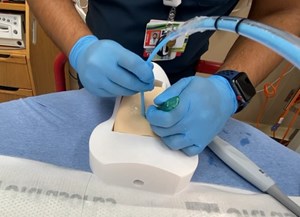
Probing the Literature National Journal Club: A Novel Approach to US-Guided Thoracostomy
Session Date: June 15, 2023
Dan Mirsch, DO, FACEP
Welcome to our summary of Probing the Literature National Journal Club, where we delve into the latest research and discussions in the field of point of care ultrasound. In June 2023, we were pleased to have Dr. Lindsay Taylor join us as a guest speaker. Here's a recap of the key points discussed during the session:
Dr. Taylor is an Associate Professor of Emergency Medicine at Virginia Commonwealth University Health System in Richmond, Virginia. She completed an ultrasound fellowship at VCU and is now the co-fellowship director of their program. She completed her residency training in Emergency Medicine at Detroit Medical Center - Sinai Grace Hospital in Detroit, Michigan. Her clinical interests include clinical and critical care ultrasound, trauma, global health, and education.
Dr. Lindsay Taylor shared her study on a novel approach to ultrasound-guided thoracostomy and explained that the inspiration for her research came from the challenges faced by providers in caring for critically ill trauma patients, particularly those with obesity. Traditional landmark techniques for thoracostomy insertion can be difficult when landmarks are obscured by redundant tissue.
She then discussed a previous study aimed at assessing the use of ultrasound guidance in improving thoracostomy site identification compared to traditional techniques. This study involved healthy volunteer medical students with normal anatomy and BMI. While it showed improvement for novice learners, the study had limitations due to its focus on normal body and anatomy.
Dr. Taylor then described the technique used in the earlier study, which involved using ultrasound to identify the diaphragm, ribs, and intercostal spaces for thoracostomy site selection. Images from the study were presented, demonstrating the process of advancing towards the appropriate zone of safety for insertion.
Her second study, the focus of this session, expanded the patient population to include stable trauma patients. Residents were randomized into either a landmark group or an ultrasound-guided group. Radio-opaque markers were used to compare the accuracy of site identification between the two groups. The study found a statistically significant improvement in the ultrasound group, with 97% accuracy compared to 88% in the landmark group.
Dr. Taylor highlighted some limitations of the study, such as the positioning of patients' arms during CT scans and the potential movement of subcutaneous tissue. The study did not involve actual chest tube placement, so further research is needed to evaluate the impact of ultrasound guidance on the insertion process.
In conclusion, Dr. Taylor suggested that ultrasound guidance could serve as a helpful double-check for novice learners and a useful tool for trainers when landmarks are difficult to identify. Additionally, in patients with abnormal anatomy, ultrasound could provide early insights into diaphragm position during the primary survey.
Key tips for researchers:
- Incorporate statisticians and seasoned researchers early in the design process and ask colleagues at ACEP EUS or AEUS for contacts or help.
- Consider different patient populations and scenarios when conducting research to gather comprehensive data.
- Pay attention to limitations and potential confounding factors in data collection, such as patient positioning, removal of markers by other staff, and subcutaneous tissue movement
- Recognize the potential benefits of ultrasound guidance for novice learners vs experienced trainees, particularly in cases where landmarks are difficult to identify.
- The process of performing the protocol or study needs to be a path of least resistance to maintain buy in and consistent performance.
- Set concrete deadlines for the research team.
- Use available resources such as medical students to assist with any element of the study.
- Write the introduction and methods before doing the study. Write the results section with a fill-in-the-blank mentality prior to initiating the study.
We extend our gratitude to Dr. Lindsay Taylor for sharing her research and insights. Stay tuned for future sessions where we continue to explore the latest advancements in point of care ultrasound.



